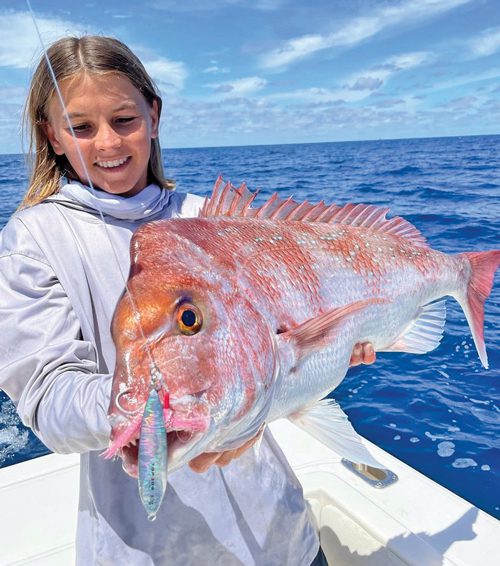Southeast Queensland has an incredibly special offshore fishery, and we’re currently in the middle of when cold water meets warm, so there is an abundance of species to chase. Top jigging tips
Personally, vertical jigging is by far my favourite go-to fishing style. There is something very satisfying about tricking a fish into smashing a chunk of metal and devouring the hooks. Top jigging tips
Surprisingly, it is much easier than newcomers to the jigging scene think and, once you dip your jig into this world, I can guarantee you’ll be hooked, particularly with how many fish this style can produce.
First, you need to understand the jig that is to be used, in what situation and for your target species.
At Top Dog Tackle, we have slow pitch jigs – these have a few names such as butterfly, flutter or even slow pitch.
To look at, they are short, wide and often vary in weight from the front to the back.
Jigs can have a range of different assist hooks on them – from single hooks to double hooks and even hooks off the top and bottom of the lure.
There is no right or wrong here – it comes down to what you the angler is most confident with.
When slow-pitch jigging, I use a double-assist hook with glow fibres and feathers.

The super-sharp double assist allows a better hook-up rate if the fish is coming in only to have a look and when they are a bit tentative on the bite.
As the names suggest, they ‘flutter’ on the drop and this drives demersal fish crazy.
I’ve caught almost all the fish species anglers want to eat – from coral trout to red emperor and the humble snapper and, more often than not, if the fishing is slow on bait, the jig will get the bite on the better fish.
As a general rule of thumb, when selecting what size jig to use, 1g per 1m of water is a good start.
So, let’s say you’re fishing in 60m of water, you’d use a 60g jig.
The more you become familiar with your jigs and depths, the more confidence you’ll gain to play around with this technique.
I’ve used 130g jigs in 30m of water, bashing the big weight to the bottom around zombies to get big angry trout to the big profile jig – the 1g per 1m is a good starting point.
The most common type of jig that people recognise is the knife jig.
These are long skinny pieces of metal that sink fast and need to be retrieved quickly to get the pelagic and oceanic fish to eat.
The knife jig is generally used in deep water situations and even in shallower water when the current is strong.
The slim line profile allows the jig to get to the bottom easier, allowing you to use lighter gear than if you were using bait.
The same as the slow pitch jig – there is no right or wrong scenarios with assist hooks.

I’ve seen fishos with hooks on the top and bottom of the lure, though my preference is one hook off the top where the line is attached because the fish that are generally eating these lures are quite aggressive.
These fish include amberjack, tuna, cobia, mackerel and even dolphinfish that are deep on a bait ball, with big mouths and pulling like crazy.
So, I don’t want two hooks pulling in weird directions when that freight train is pulling line from the reel.
One of the less intense styles of jigging is the slow-pitch technique.
As the name suggests, this style involves slowly working the smaller wider jigs through the water column.
It’s a simple lifting of the rod tip and letting the jig ‘flutter’ back down 1m or so before lifting the rod tip again.
When chasing snapper off the Sunshine Coast – my home grounds – this is by far the deadliest action for fish that aren’t feeding up in the water column.
The more erratic style of jigging that most people would associate jigging with is the short sharp lifts of the rod tip and the winding of the reel to get the metal to jig its way through the water column.

This style is much more labour intense on the angler, though for some strange reason, when you feel that big fish trying to eat your lure two or three times before its hooked, fatigue levels are quickly forgotten!
This style of jigging can be used with both the knife and slow-pitch jigs.
The knife jigs are generally kept to a speedy retrieve, where the slow-pitch jigs can work fast or a little slower to incise the reef fish that are actively feeding higher in the water column.
As mentioned, we are very lucky in southeast Queensland, with a wide range of both warm and cold-water species.
For me this means one thing only… we can jig all year-round.
If you keep a full jig bag of both slow pitch and knife jigs, you can chase all our winter species on the bottom and then have endless fun with the big schools of amberjack and other fish in the warmer months.
So, if you’re a first timer to the jigging scene or even a seasoned professional… happy jigging!
Dyllon Schulz
Top Dog Tackle
 Bush 'n Beach Fishing Magazine Location reports & tips for fishing, boating, camping, kayaking, 4WDing in Queensland and Northern NSW
Bush 'n Beach Fishing Magazine Location reports & tips for fishing, boating, camping, kayaking, 4WDing in Queensland and Northern NSW








